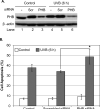Lipid rafts association and anti-apoptotic function of prohibitin in ultraviolet B light-irradiated HaCaT keratinocytes
- PMID: 22776003
- PMCID: PMC3395203
- DOI: 10.1111/j.1600-0625.2012.01547.x
Lipid rafts association and anti-apoptotic function of prohibitin in ultraviolet B light-irradiated HaCaT keratinocytes
Abstract
Upon UVB irradiation, an alternation of major lipid raft components can lead to the recruitment/activation of rafts-associated proteins and initiation of downstream apoptotic signalling pathways. We used two-dimensional gel electrophoresis (2-DE) to identify potential regulators of UVB-induced apoptosis and mass spectrometry fingerprint analysis to identify proteins that are altered in the rafts after UVB irradiation. Our data show that levels of several proteins, including prohibitin (PHB), were changed in lipid rafts after UVB irradiation. We also demonstrate that while total PHB expression was not changed, the protein was enriched in lipid rafts after UVB irradiation. Reduced expression of PHB using siRNA knockdown resulted in an increase in cellular apoptosis after UVB irradiation. Based on these results, we propose that PHB protects keratinocytes from UVB-induced apoptosis.
© 2012 John Wiley & Sons A/S.
Figures


Similar articles
-
The role of lipid raft translocation of prohibitin in regulation of Akt and Raf-protected apoptosis of HaCaT cells upon ultraviolet B irradiation.Mol Carcinog. 2017 Jul;56(7):1789-1797. doi: 10.1002/mc.22636. Epub 2017 Mar 6. Mol Carcinog. 2017. PMID: 28218425 Free PMC article.
-
The role of cholesterol in UV light B-induced apoptosis.Photochem Photobiol. 2012 Sep-Oct;88(5):1191-7. doi: 10.1111/j.1751-1097.2011.01038.x. Epub 2011 Dec 16. Photochem Photobiol. 2012. PMID: 22077874 Free PMC article.
-
Synergistic phototoxic effects of glycolic acid in a human keratinocyte cell line (HaCaT).J Dermatol Sci. 2011 Dec;64(3):191-8. doi: 10.1016/j.jdermsci.2011.09.001. Epub 2011 Sep 24. J Dermatol Sci. 2011. PMID: 21993420
-
Starting and propagating apoptotic signals in UVB irradiated keratinocytes.Photochem Photobiol Sci. 2009 Mar;8(3):299-308. doi: 10.1039/b813346h. Epub 2009 Jan 5. Photochem Photobiol Sci. 2009. PMID: 19255669 Review.
-
Role of tumor necrosis factor-α in the regulation of keratinocyte cell cycle and DNA repair after ultraviolet-B radiation.Dan Med Bull. 2010 Oct;57(10):B4179. Dan Med Bull. 2010. PMID: 21040686 Review.
Cited by
-
The role of photolabile dermal nitric oxide derivates in ultraviolet radiation (UVR)-induced cell death.Int J Mol Sci. 2012 Dec 21;14(1):191-204. doi: 10.3390/ijms14010191. Int J Mol Sci. 2012. PMID: 23344028 Free PMC article. Review.
-
Multifaceted role of prohibitin in cell survival and apoptosis.Apoptosis. 2015 Sep;20(9):1135-49. doi: 10.1007/s10495-015-1143-z. Apoptosis. 2015. PMID: 26091791 Free PMC article. Review.
-
Prohibitin 1 inhibits cell proliferation and induces apoptosis via the p53-mediated mitochondrial pathway in vitro.World J Gastrointest Oncol. 2024 Feb 15;16(2):398-413. doi: 10.4251/wjgo.v16.i2.398. World J Gastrointest Oncol. 2024. PMID: 38425403 Free PMC article.
-
Inhibition of insulin/IGF-1 receptor signaling protects from mitochondria-mediated kidney failure.EMBO Mol Med. 2015 Mar;7(3):275-87. doi: 10.15252/emmm.201404916. EMBO Mol Med. 2015. PMID: 25643582 Free PMC article.
-
Prohibitin: targeting peptide coupled to ovarian cancer, luteinization and TGF-β pathways.J Ovarian Res. 2017 Apr 20;10(1):28. doi: 10.1186/s13048-017-0325-4. J Ovarian Res. 2017. PMID: 28427435 Free PMC article.
References
-
- Brown DA, Rose JK. Sorting of GPI-anchored proteins to glycolipid-enriched membrane subdomains during transport to the apical cell surface. Cell. 1992;68(3):533–44. - PubMed
-
- Bayer M, et al. Photoprotection against UVAR: effective triterpenoids require a lipid raft stabilizing chemical structure. Experimental dermatology. 2011;20(11):955–8. - PubMed
Publication types
MeSH terms
Substances
Grants and funding
LinkOut - more resources
Full Text Sources

